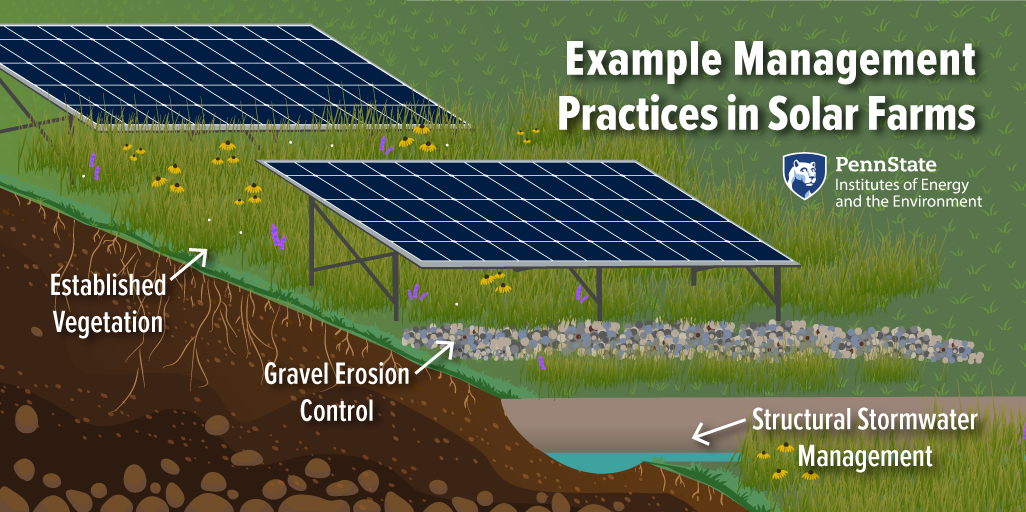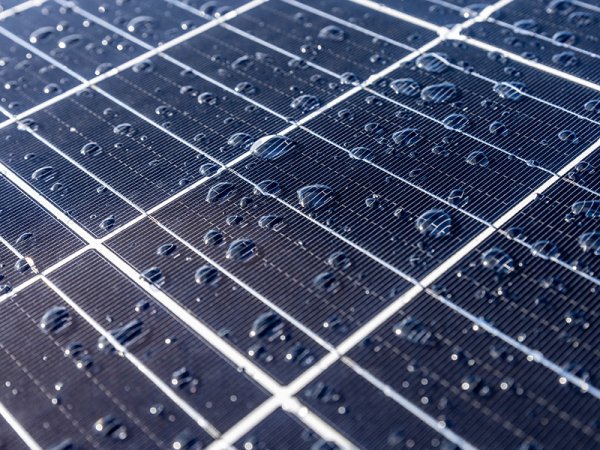Major ground-mounted solar panel installations, often called “solar farms,” are rapidly growing in Pennsylvania and around the world. Solar farms are part of a critical effort to increase our renewable energy portfolio and reduce our carbon footprint. However, due to their size (often covering hundreds of acres), solar farms have the potential to impact natural hydrological and ecological processes. With adequate consideration of best management practices, any negative impacts of solar farms on the landscape can be minimized, and solar farms could potentially generate net positive changes in ecosystem services or benefits provided by nature.
Because solar farms are a newer land use, there is still relatively little research to inform best land management practices. Additionally, guidance from regulatory agencies relating to any stormwater management recommendations or requirements varies by state. To better understand the impacts of solar farms on the ecosystem, we recently summarized the current scientific research regarding solar farm impacts on landscape soils, vegetation, and hydrology.
Existing research from around the world has found variable impacts of solar panels, depending on site characteristics such as soils or slope, as well as site management practices, such as vegetation type and management. In some cases, there were undesirable changes in soil characteristics, such as a decreased ability of water to infiltrate the ground or decreased organic matter, which can be an indicator of soil health. In other sites, there was no difference. Many of the evaluated sites were solar farms developed a decade or so ago, so it is possible that evolving understanding of best practices will reduce impacts on soil properties. For example, some older solar farms may have had more extensive earth disturbance during the construction process than is currently recommended.

As for vegetation, there is typically shorter and less coverage of vegetation under panels due to shading. However, in more arid, sunny regions like Arizona, there can actually be more vegetation present under the panels, where the shading reduces water stress. In water-plentiful regions like Pennsylvania, well-established healthy vegetation is critical to helping stormwater slow down and soak into the ground, as well as providing other benefits such as pollinator habitat.
As for whether solar farms lead to net increases in stormwater runoff, there is almost no research answering this question yet. Colleagues in the midwestern US are currently wrapping up hydrology research on several solar farm sites and recently released a new solar farm-specific runoff modeling tool for use by solar farm planners.
When we reviewed guidance on managing solar farm landscapes to minimize stormwater concerns, we found current guidance to be variable. As of 2022, twelve states, including Pennsylvania, had solar farm-specific guidance about stormwater management. For other states, solar farm development is still subject to federal rules related to the Clean Water Act and minimizing water pollution, but there is not necessarily solar farm-specific guidance relating to stormwater management. In reviewing the guidance from states with solar farm-specific stormwater management guidance, some of the key best practices are minimizing construction-related compaction, ensuring a high cover of perennial vegetation with minimal maintenance, and designing with pervious space between solar panel rows to promote infiltration of any runoff; in some cases, constructed stormwater management features like engineered infiltration basins may be required.
Because there is a need for additional insights on how to best manage solar farm landscapes to maximize environmental benefit, we have initiated some field research in central Pennsylvania. In our region, some of the challenges include “less-than-ideal” sites such as those with high slopes, karst geology, and rocky outcrops. We are currently using environmental sensors and sampling to help us understand whether solar farms impact how water moves in the landscape, and whether we should consider any changes to currently recommended management practices. We are also partnering with other researchers at Penn State to collect data on other benefits, such as soil carbon accumulation and vegetation and insect diversity. Other colleagues are also working to explore novel management strategies for solar farms, such as grazing sheep amongst the panels to help manage vegetation and provide additional economic and agricultural benefit.
In addition to pursuing low-impact development of solar farms, it is worth noting that rooftop solar provides a means of harnessing solar energy on already-existing impervious surfaces. Thus, there is no potential for additional changes to runoff patterns as there could be with solar farms. It is important to continue to promote opportunities to expand rooftop solar development on residential buildings, larger commercial buildings, as well as in parking lots - where solar panels can provide the added benefit of shade for vehicles. All this information can help us determine how to reap the benefits of solar energy, while maximizing additional ecosystem benefits and minimizing any negative environmental impacts.
Lauren McPhillips is an assistant professor in the Department of Civil and Environmental Engineering. Her research focus is water resources engineering with interest areas including water quality. stormwater management, green infrastructure, urban ecohydrology, and biogeochemistry.
Rouhangiz (Nasim) Yavari is a graduate student pursuing her doctoral degree. Her research focus is green infrastructure planning and the hydrology impacts of solar farms. She is a member of McPhillips' Research Group, which works on challenges related to sustainable and resilient management of water in human-dominated landscapes.
References:
Yavari Bajehbaj, R., D. Zaliwciw, R. Cibin, L. McPhillips. (2022) Minimizing environmental impacts of solar farms: a review of current science on landscape hydrology and guidance on stormwater management. Environmental Research: Infrastructure and Sustainability.







